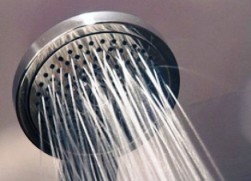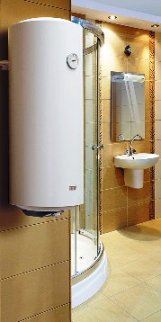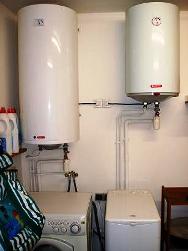Categories: Featured Articles » Sharing experience
Number of views: 42856
Comments on the article: 5
Do-it-yourself selection, installation and connection of an electric water heater
 A detailed description of the selection and installation of an electric water heater in the apartment
A detailed description of the selection and installation of an electric water heater in the apartment
Disruptions in the supply of hot water to our apartments and houses occur quite often, and in some cities and regions it is simply regular and this causes great inconvenience to many families.
If the house has small children, then the lack of hot water from a small temporary inconvenience turns into a real problem. However, solving this problem is quite simple and not even too expensive by installing an electric water heater.
First, let's decide what principle of action do you need a flow or storage heater. Instantaneous electric water heater is cheaper, much more compact in size and very easy to install. However, one significant drawback often makes its use in apartments unacceptable, it is high power.
And the point here is not even a large consumption of electricity, a flow heater instantly brings the water to the desired temperature, and does not spend electricity for 30-40 minutes to heat a large volume of water as boiler (storage water heater). It’s just that when the instantaneous water heater operates, the load on the electric network is too high, for which it simply is not designed.
 Power instantaneous water heaters It varies from 3 to 8 kW, and at 3 kW you can wash your hands maximum, for a shower or bath you will need at least 5 kW. With a power of 5 kW, in single-phase voltage networks, the current strength is approximately 23 A, and if you have old wiringthen an aluminum cable of 2.5 mm2 is laid for which a load of 20 A is already ultimate. Therefore, if you want to install a instantaneous water heater, you will have to pull a separate cable from the switchboard. Plus, you need to look at the cross section of the cable supplying your shield and calculate whether it can withstand the additional load.
Power instantaneous water heaters It varies from 3 to 8 kW, and at 3 kW you can wash your hands maximum, for a shower or bath you will need at least 5 kW. With a power of 5 kW, in single-phase voltage networks, the current strength is approximately 23 A, and if you have old wiringthen an aluminum cable of 2.5 mm2 is laid for which a load of 20 A is already ultimate. Therefore, if you want to install a instantaneous water heater, you will have to pull a separate cable from the switchboard. Plus, you need to look at the cross section of the cable supplying your shield and calculate whether it can withstand the additional load.
Storage water heater power usually does not exceed 2 kW, so it can be connected to a common outlet. According to the design of the storage tank, the heaters are vertical and horizontal, round and flat.
The form does not affect the technical characteristics, choose a heater in accordance with your ideas about the design and the availability of free space for placement. But keep in mind that models with a flat tank will cost significantly more than round ones. The case is most often made of plastic, the inner tank is stainless steel.
Determine the volume, if we are talking about an apartment enough tank from 30 to 50 liters. A 30 liter water heater will be enough to shower and wash a family of three, but if you want to get a hot bath, 30 liters is not enough.
With a tank of 50 liters, this can already be done. Of course, you can choose a water heater for 80, 100 liters, just keep in mind that along with the volume, the time for heating the water will increase, and the temperature will have to be maintained in a larger volume, and, consequently, will increase power consumption.
Thirty liters will be heated for 40-50 minutes, and 50 liters is already 1h 10-1h 20. The optimum power for a thirty-liter heater is 1.5 kW, and for a tank of 50 liters it’s nice to have two plug-in heaters, say, the first with a power of 1.2 kW and the second 0.8 kW. And it is also very important that the heater was equipped with a thermostat, and it was possible to set the desired heating temperature.
So, we bought an electric water heater and install it in a pre-selected place. In an apartment, he is most often located in the toilet over the toilet.All models up to 200 liters are made wall-mounted, the kit comes with a special strip, which we attach to the wall on an anchor or dowel-nails and hang a heater on it.
 Now the most interesting thing is to bring water to it. If plastic pipes leave your riser, then there are no problems and you do not need to call the plumber for installation. You need to get a welding machine for plastic pipes with couplings of the desired diameter (most often d20 is enough) and scissors for cutting pipes.
Now the most interesting thing is to bring water to it. If plastic pipes leave your riser, then there are no problems and you do not need to call the plumber for installation. You need to get a welding machine for plastic pipes with couplings of the desired diameter (most often d20 is enough) and scissors for cutting pipes.
All this can be bought if you plan to use it in the future, but you can rent it in almost any plumbing store. Even if you have never used a pipe welding machine, it will be very easy to understand its operation. It is also necessary to buy plastic pipes of the desired diameter, as a rule, this is ½ inch or 20 mm, which is one and the same.
We measure the distance from the pipes of hot and cold water supply to the connecting pipes located at the bottom of the water heater and according to this we purchase pipes. You will also need two tees of the corresponding diameter, two taps for hot and cold water and two couplings with a union nut for connection to a water heater. And, a little advice, do not take plastic made in China, it is better to give preference to Russian, German or Czech companies.
In the chosen place, with the help of scissors we cut the pipe of cold water supply and weld the tee there. The pipe departs from the tee to the water heater, on it in a place convenient for access, we install a crane for supplying cold water to the water heater and at the end we weld the sleeve with a union nut, with which we connect to the heater inlet pipe.
We tighten with a cap or gas wrench, the connection is threaded, so tape-fum or plumbing thread should be applied to the thread. We do the same with a hot water pipe and attach it to the outlet pipe of the water heater. Plumbing work is completed.
Our electric water heater, so you need to connect it to the electrical network. With some models of electric water heaters, a power cord is included, but if it is missing, we will do it ourselves.
We measure a piece of copper three-core cable with a cross section of at least 1.5 mm2 to the outlet into which the water heater will be turned on and install a plug with grounding at the end. The second is inserted into the terminal box of the water heater and connected, the main thing is to connect the earth wire correctly, usually the terminal block is connected to the case using a yellow-green wire.
Everything is done, and you can test. Turn off the hot water supply from the riser, open the tap on the cold water supply to the water heater and at the outlet of hot water from it. Apply power to the water heater and install temperature controller to the maximum. Wait for the heating time set in the passport, while carefully inspecting the pipe connections for leaks. And if everything is fine, open hot water and use to your pleasure. Now you are not afraid of any shutdowns of hot water.
Mikhail Barsukov
See also at e.imadeself.com
:
